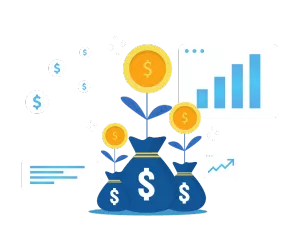
Every day, businesses are actively seeking methods to maximize their budget. One strategy businesses are adopting is split funding. Split funding refers to the practice of automatically deducting a fixed percentage of a business’s daily credit card sales as repayment for a business loan. When a business receives a merchant cash advance, the lender “splits” the business’s daily sales to repay the loan. Through split funding, entrepreneurs can pay for business expenses like inventory, utilities, insurance, advertising, and more. However, split funding offers other benefits that improve business operations and costs.
Keep reading to discover what is split funding, how it works, and the benefits, types, and uses.
What Is Split Funding?
As previously mentioned, split funding automatically deducts from a business’s daily credit card sales to repay a business loan. This method streamlines the loan repayment process for businesses, particularly those with a significant portion of their revenue generated through credit card transactions.
How Does Split Funding Work?
The business’s credit card sales are split to repay the MCA provider automatically. This provides some flexibility for businesses because the repayments are linked to their daily revenue. When sales are high, more is paid, and when sales are low, the repayment amount decreases.
Benefits of Using Split Funding for Business Owners
Split funding can help you allocate your funds better, keeping your business in order. This is how split funding can help you better manage your financial resources:
- Predictable Repayment Structure: Business owners know exactly what percentage of their daily credit card sales will be allocated for loan repayment, making it easier to plan their finances and manage cash flow.
- Flexibility in Cash Flow Management: On days with higher sales, businesses repay more, and on less busy days, the repayment amount decreases, reducing the financial strain during slow periods.
- Quick Approval and Funding: Split funding arrangements often have a faster approval and funding process compared to traditional loans, making it a viable option for businesses in need of immediate capital.
2 Types of Split Funding Models
It’s important for businesses to implement a split funding model that takes care of both their current and future needs. Merchants can split funds through two models.
Customized split funding
With customized split funding, the business and the lending institution agree on a repayment plan tailored to the business’s needs. They basically set the distribution rules and specify how much funds go to what account. This model allows for a high degree of flexibility and personalization in setting the repayment terms.
If people are discovering your site through affiliates, then customized split funding comes in handy. For example, when a customer buys an item online, customized split funding splits the funds from a transaction between the site, affiliates, and other involved entities.
Pre-defined split funding
With pre-defined split funding, the lender deducts a fixed percentage of daily credit card sales from the business. The lender withholds their fees from the revenue and the rest of the amount goes to the merchant.
Pre-defined split funding is useful with businesses that store stocks of merchandise from several suppliers. Using split funding, merchants retain the markup when they sell shorts, but the rest goes to the supplier. If they sell shoes, the funds can end up with a different supplier while the store keeps its share.
Uses of Split Funding Working Capital
Businesses can use split funding to invest in working capital by leveraging the predictable and flexible repayment structure that split funding provides. Here’s how businesses can use this financing method to bolster their working capital:

Day-to-day business expenses
Adequate working capital is essential for daily business operations. Split funding can ensure that businesses have a consistent source of capital to keep their operations running smoothly, whether it’s a retail store, restaurant, or an e-commerce business.

Marketing and advertising
Another great way to use split funding is for marketing and advertising purposes. Whatever your target audience is, investing in affiliate, digital, and traditional marketing can exponentially increase brand awareness.

Purchase inventory and equipment
Equipment such as computers, POS systems, and machines can be costly. Split funding allows business owners to purchase merchandise and equipment before they run out of funds because many vendors demand large upfront payments.

Employee and new hire training
Working capital can fund many growth initiatives. Whether it’s expanding the business, launching new products or services, or entering new markets, having access to capital through split funding can fuel these expansion efforts.

Manufacturing costs
Product manufacturing can also be a constant financial need that business owners should be aware of. This is most noticeable during slow periods or when the demand for your product is so high, that you have to meet inventory quotas quickly. You can utilize split funding to always have working capital cash on hand for manufacturing costs at all times.

Research and development
Putting your working capital from split funding to good use also means investing in research and development. Staying on top of competition means constantly developing your products, goods, and services. For this reason, many merchants will use split funding to pay for research and development.

Leasing office or business space
If you’re just an online store and have decided to open up a brick-and-mortar store, then split funding is the perfect solution to pay for it. Split funding provides the financial flexibility, stability, and control necessary to successfully bridge the gap between online and offline retail operations.

Debt Repayment
Split funding can be an effective tool for managing and repaying business debts. Whether you have borrowed funds for expansion, invested in inventory, or taken out a loan for any other business-related purpose, allocating a portion of your revenue to debt repayment through split funding can offer several advantages.
Split Funding Qualifications
To benefit from split funding, you first need to meet the eligibility criteria for a business loan, specifically for a merchant cash advance. The qualifications can vary depending on the lender or funding provider. Lenders may have minimum monthly or daily credit card sales requirements. Just like with any other business loan, lenders will consider the business’s credit history, industry type, financial history, and other financial obligations when determining approval or business loan terms.
How to Apply for Split Funding
To increase the likelihood of approval, businesses should present documents that meet the lender’s qualifications and fulfill the repayment requirements. Common documents that lenders will ask for when applying for a business loan include bank statements, credit card processing statements, business tax returns, and other financial records. Some lenders specialize in serving specific industries, so finding a lender that understands your industry can be beneficial.
Final Thoughts on Split Funding for Businesses
Split funding is a valuable financial tool for businesses, offering a versatile approach to managing revenue and meeting financial goals. Whether it’s for debt repayment, expansion, or other specific financial needs, split funding proves to be a strategic support.
As previously mentioned, split funding is a repayment method for a merchant cash advance by automatically allocating a portion of a business’s daily credit card sales to repay the lender. To make the most of this financing opportunity, it’s crucial to actively seek out a business loan provider. A merchant cash advance loan provider can offer capital, expertise, flexibility, and tailored solutions to meet the specific needs of your business!







